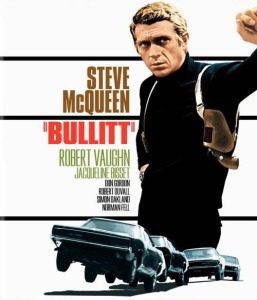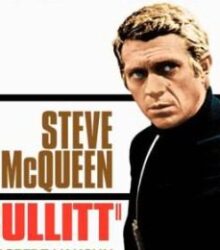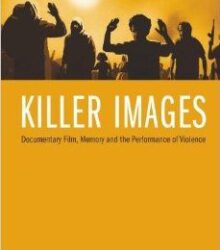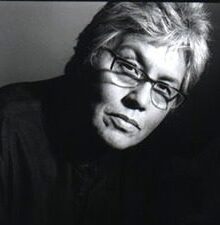The Portillo Project
Portillo Explodes Popular Cultural Myths That Fix Collective Senses of Identity
By Mary Moylan
 Set in San Francisco, the documentary My McQueen(2003), directed by Lourdes Portillo, takes on an exploration of a very interesting frontier, the Mexican American frontier- a key moral, political and geographical frontier that she considers throughout the full range of her filmic career. The documentary features Portillo together with her long time filmmaking partner, Kyle Kibble, as they deconstruct with an ironic humor, the 1968 film, “Bullitt.” Perched upon directors’ chairs in front of a large movie screen- they each engage one another in an informal way, and, in a Barthian sense, unpack the myth of the American male stereotype. Kibble, a white middle aged male, found “Bullitt” to be integrating where as Portillo found it alienating from the outset, and they both say why. And it is their discussion about this that is constructing a particularly mythic form for American male identity and also setting particular structural forms for this film- as Bullitt sets up a whole genre for car chase movies.
Set in San Francisco, the documentary My McQueen(2003), directed by Lourdes Portillo, takes on an exploration of a very interesting frontier, the Mexican American frontier- a key moral, political and geographical frontier that she considers throughout the full range of her filmic career. The documentary features Portillo together with her long time filmmaking partner, Kyle Kibble, as they deconstruct with an ironic humor, the 1968 film, “Bullitt.” Perched upon directors’ chairs in front of a large movie screen- they each engage one another in an informal way, and, in a Barthian sense, unpack the myth of the American male stereotype. Kibble, a white middle aged male, found “Bullitt” to be integrating where as Portillo found it alienating from the outset, and they both say why. And it is their discussion about this that is constructing a particularly mythic form for American male identity and also setting particular structural forms for this film- as Bullitt sets up a whole genre for car chase movies.
In effect, an antique car buyer who is interviewed in the documentary expresses what Kibble and Portillo say and in particular, what Portillo says explicitly, that the American male identity is tied up with the car. They are their car- their car is them. This is a simplistic version almost- of male identity, but because it is simplified it is not necessarily wrong. As Kibble says, people come out of the movie, they sit in their car, and they think that they are Bullitt. They think they are in a car chase. They think that their car is a Mustang, and so on.
Very early on in this documentary, Portillo uncovers an intriguing moral dimension to “Bullitt” depicted in this documentary within a stream of trailers from the feature film. Here, a claim is made that the film ushers in a new kind of cinematic realism. “Bullitt” is after all, made on location in San Francisco. It leaves the studio, it leaves Hollywood, it’s taking place in a real location. And, just as Steve McQueen/Bullitt becomes a mythic form of male identity, so “Bullitt” becomes a mythic form of the action film genre. And part of its mythic character is that which Portillo is constantly trying to explode, it is that the realism, which is, the film genre or sub genre is itself a model or a myth. What is supposed to be realistic isn’t realistic at all. After all, they do clear the streets for the car chase, or, the “Real Doctors” in the beginning of the film, are quite obviously actors etc. And what we can glean is that these popular cultural myths really do fix collective senses of identity. And what Portillo is identifying is just how difficult it is to change this- and that actually a key figure for her in a contemporary geopolitical ethno- cultural context is the Latino American male.
Contrasting Steve McQueen/Bullitt, the white middle class male, with a minority American male, Portillo introduces the Latino actor, Sean, into the documentary. He comes from the minority sub culture that she comes from and what is interesting and one of the reasons Portillo made this film is that for her, Sean is more Bullitt than Steve McQueen has ever been. In other words, what Bullitt is representing is what the vintage car buyer is representing –a culture that has past, a dominant culture that no longer is the norm. San Francisco has changed over the 40 years that have passed. The documentary is looking at this at the level of socio- cultural or ethno cultural change in an American context. Kibble and Portillo are working at this at the level of generational change; she and Kibble were 40 years younger when Bullitt was made.
Playing around with the visuals the whole time, the documentary starts with the portrayal of the young Asian American man, as he appears to draw the Latino actor, Sean, but he is not drawing Sean. He is drawing Steve McQueen. And this Asian actor is located with the playing of the car chase as the back- drop that fills the screen. And It is made very explicit, the screen on which the movie Bullitt is being played is only a part of the contents of the screen- you have Sean in there, sometimes looking in the mirror, sometimes not. Or, we see him as he plays with the model cars. You have Portillo and Kibble talking and they are in what is recognizably a larger interior space. Just as we see Sean in the mirror, there is a wonderful echo here of the scene in Taxi Driver, with Robert De niro in the mirror, as he rehearses his transformation of his image before he goes out with the knife and starts really laying about him.
Portillo has an initial contention that McQueen is narcissistic (I mean what actor is not narcissistic) and so, is clearly making a moral criticism of him. But it is not at all clear where she is coming from, other than perhaps as a critical feminist. But this does not get explored. What are the implications of the narcissistic aspect of this form of the image of male identity? Why is that a moral issue? Narcissism as a critical concept, as a concept of moral critique doesn’t continue to have that force in the documentary. So, just as she plays those scenes where McQueen is with the actress, Jacqueline Bisset, Portillo is challenging his silence- to which he has no response. Kibble is quite interesting on that, he says, American male identity is action rather than words. And that of course, is the whole ethos for example, of the Western hero, the man who restores order, or, who is responsible for sustaining order. It’s Gary Cooper in “High Noon” and it’s Alan Ladd in “Shane” or Randolf Scott, for example. It’s the Magnificent Seven that offers the kind of cross-cultural myth. “My McQueen” engages the Japanese myth in “Seventh Samauri.” The narrative of Seventh Samauri transfers in the context of Portillo’s critique of a very interesting frontier, depicting a strong feature of the mythic historiography of the West.
So, what the producers of “Bullitt” keep pushing about “Bullitt” in those trailers (and they hardly need to) is that it is a new genre in the generic structure of the western. The rogue cop, or the unorthodox cop, is after all, a law- maker. And “Bullitt” is in the city rather than in the country –side, or the frontier. He is in a car, rather than on horseback, etc. In “Bullitt”, the representation is that McQueen’s silence is a mark of his virtue-he acts rather than debates. Where as Portillo’s take is that the quiet ones, in Latino culture, are the ones to watch out for.




